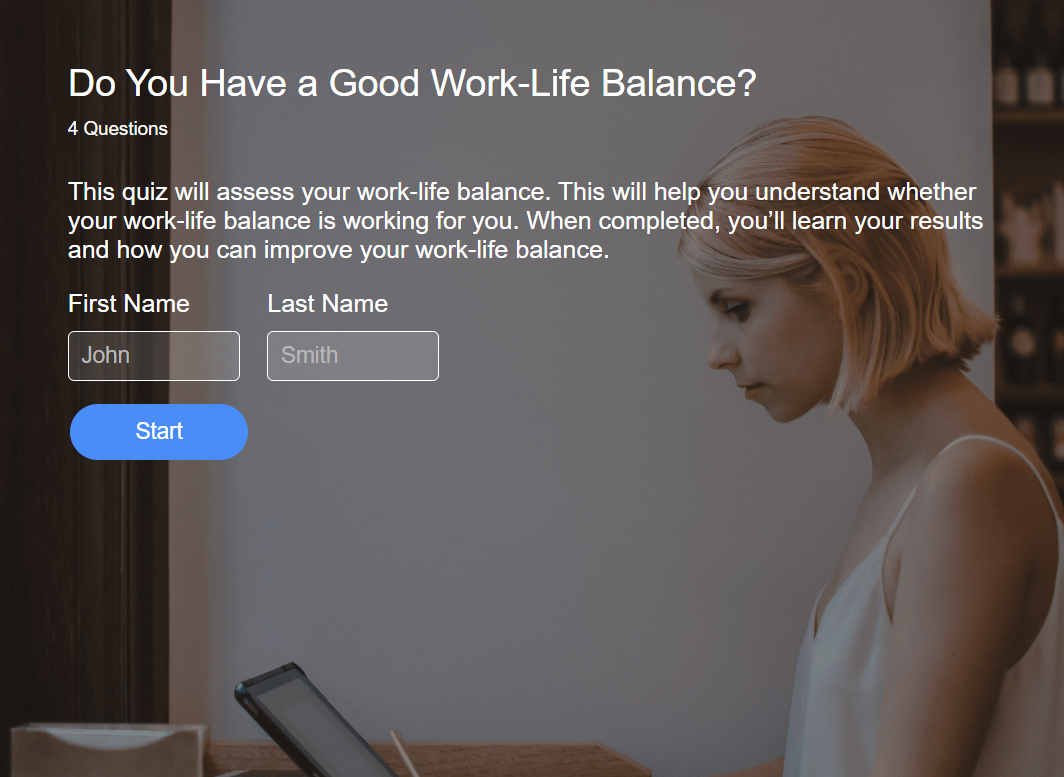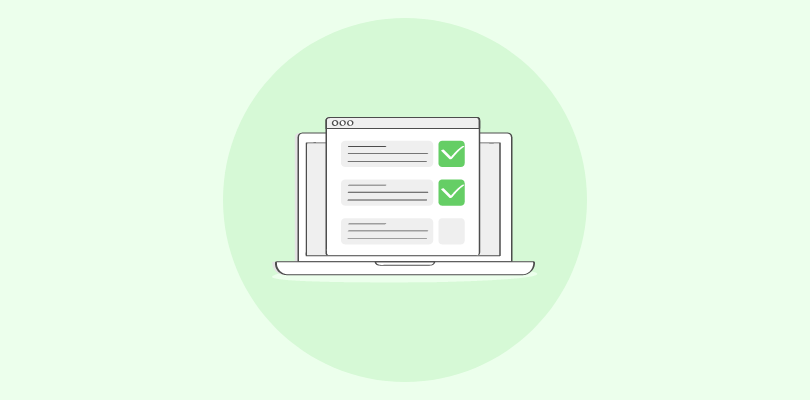The quiz vs test debate has followed me through every stage of designing learning programs. Early in my career, I treated them the same—just different names for checking knowledge. Over time, realizing the difference helped me create better learning paths.
I’ve seen teams struggle with engagement simply because they used a formal test when a quick quiz would’ve worked better. I’ve also watched learners feel confused or unprepared because a casual quiz suddenly turned into a high-stakes evaluation.
In this post, I’ll share what I’ve learned about when to use quizzes versus traditional tests, what each does best, and how choosing the right approach can dramatically improve results.
Why Does the Quiz vs Test Debate Matter?
The distinction between a quiz and a test isn’t just a technicality—it shapes how people absorb and apply knowledge.
I learned this firsthand while designing an onboarding program for a growing sales team. We used long, end-of-module tests to evaluate understanding, but most reps forgot half the material within a week.
When we switched to short, topic-based quizzes spread across the training, something changed. Engagement went up, and knowledge retention improved dramatically. That experience taught me that assessments don’t just measure progress—they create it.
So, before choosing between a quiz and a test, it’s worth asking: what’s the real goal—measuring performance, or reinforcing learning?
What’s the Difference? Quiz vs Test vs Exam
All three measure learning, but they serve different purposes at different stages of a learner’s journey. Understanding how each fits makes it easier to design assessments that do more than evaluate — they help people learn better.
1. Quiz
A quiz is a quick checkpoint. It’s short, informal, and often used to reinforce learning rather than grade it.
Because quizzes are low-stakes, learners can experiment, make mistakes, and get instant feedback. They work best for keeping learning active and spotting knowledge gaps before they grow.
2. Test
A test is more formal and structured. It’s typically used after a lesson or unit to measure proficiency on specific objectives. Tests carry more weight, are usually graded, and help determine whether learners can apply what they’ve learned — not just recall it.
A balanced test includes both objective and applied questions, offering a fuller picture of comprehension.
3. Exam
An exam is the most comprehensive and high-stakes form of assessment. It evaluates cumulative knowledge — everything learned across a course or program.
Exams often include strict controls like proctoring or time limits because the results carry real-world implications, such as certification or qualification. They don’t just measure learning; they validate achievement.
Watch: How to Add Time Limits to a Quiz
Quiz vs Test vs Exam: Comparison at a Glance
| Aspect | Quiz | Test | Exam |
|---|---|---|---|
| Purpose | Reinforce and assess progress | Measure understanding of key objectives | Certify mastery across topics |
| Length | 5–15 questions | 20–50 questions | 50+ questions or multi-section |
| Stakes | Low — formative | Medium — evaluative | High — summative |
| Timing | During lessons | After units or modules | End of course or term |
| Feedback | Instant | Structured and graded | Minimal, post-evaluation |
| Environment | Informal | Formal | Controlled or proctored |
| Best For | Retention and engagement | Measuring topic-level understanding | Validating overall competence |
When to Use Quizzes vs Tests
Knowing the difference is one thing. Knowing when to use each is what makes your assessment strategy effective. The right choice depends on timing, intent, and the learning outcome you want to achieve.
Use Quizzes When:
- You’re reinforcing new learning. After every lesson, training session, or workshop, a quick quiz helps learners recall and apply what they’ve just learned. It’s a way to strengthen memory through active recall.
- You want to keep engagement high. Quizzes break the monotony of long sessions and give learners instant feedback. They also signal progress — small wins that help maintain motivation.
- You need fast insights. Instructors and managers can quickly see what’s working and what’s not. If half the team misses a question, that’s your cue to revisit that topic.
- You’re building comfort with assessments. Frequent, low-stakes quizzes help reduce anxiety by normalizing testing as part of the learning process, rather than a judgmental experience.
Use Tests When:
- You’re evaluating comprehension over time. Tests make sense at the end of a module, unit, or training phase to see how well learners have retained and integrated key concepts.
- You’re assigning grades or validating skills. A test works best when you need a formal measure of performance — something that can be recorded, compared, or certified.
- You’re tracking progress across stages. In structured courses, tests provide benchmarks — helping you identify who’s ready to advance and who needs support.
- You need credibility and accountability. In professional or academic contexts, test results often serve as proof of competence or regulatory compliance, so they carry more weight than quizzes.
The most effective learning programs use both. Quizzes act as stepping stones that prepare learners for the rigor of tests, while tests validate that the learning has truly taken hold.
How to Choose Between a Quiz and a Test
Choosing between a quiz and a test isn’t just about format — it’s about intent. Before creating an assessment, step back and ask: What am I trying to achieve with this?
1. Clarify the Purpose
If you’re trying to reinforce learning or check comprehension, choose a quiz.
If your goal is to evaluate mastery or validate skills, a test is the better fit.
2. Match It to the Learner’s Stage
Use quizzes early in the learning journey to guide understanding.
Use tests later to confirm that learners can apply what they’ve learned in context.
3. Align Difficulty With the Outcome
A quiz should feel exploratory. A space for learners to experiment and grow.
A test should challenge recall and application but remain fair and purposeful.
When assessments are designed with intent, they stop feeling like interruptions and start functioning as extensions of the learning process itself.
How to Make Quizzes More Effective
A well-designed quiz can do far more than check recall — it can fuel learning. When crafted intentionally, quizzes create curiosity, highlight blind spots, and make learners more confident over time.
1. Keep It Short and Specific
Limit each quiz to one topic or learning objective. Five to ten well-written questions are usually enough. Focused quizzes reduce fatigue and make feedback more meaningful.
2. Provide Immediate, Constructive Feedback
Instant feedback transforms a quiz from a test into a learning moment. Add short explanations after each question to help learners understand why an answer is correct.
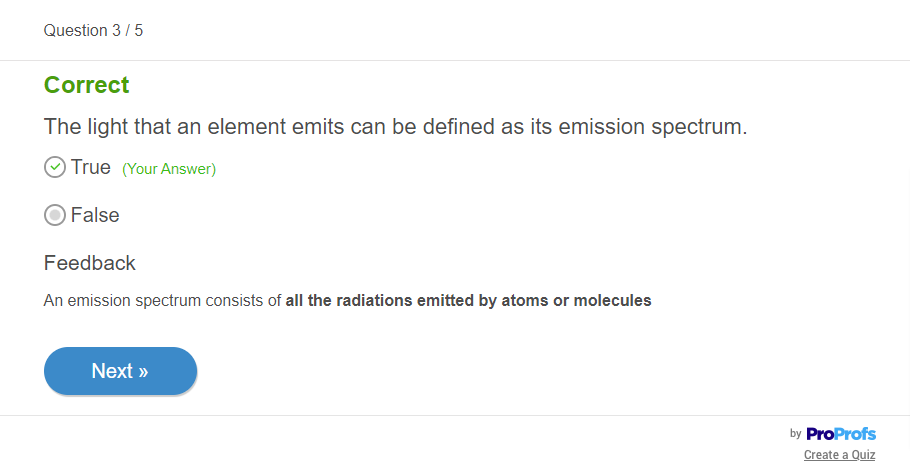
3. Mix Recall and Application
Blend factual questions with real-world scenarios. For example, pair multiple-choice items with short case-based questions to test understanding and application together.
4. Build Consistency Into Your Schedule
Regular quizzes encourage repetition, which strengthens retention. Try adding one short quiz per lesson or training module instead of saving everything for the end.
5. Use Quiz Data as a Teaching Tool
Track performance patterns. If several learners miss the same question, it’s not a learner problem — it’s a signal to revisit that topic or how it’s taught.
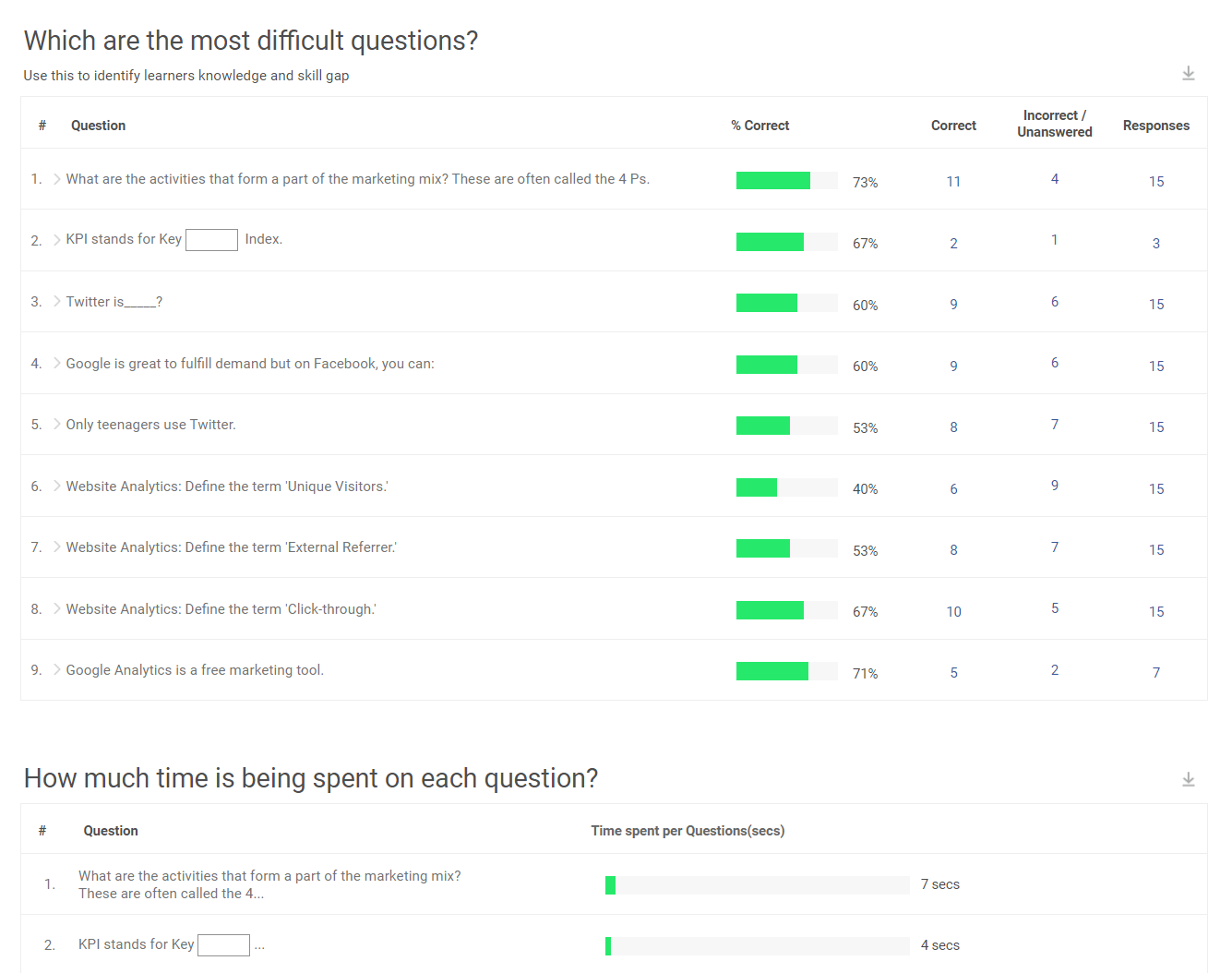
Done right, quizzes turn assessment into reinforcement. They help learners remember longer, engage deeper, and approach tests with greater confidence.
FREE. All Features. FOREVER!
Try our Forever FREE account with all premium features!
How to Design Tests That Measure Mastery
Tests should do more than collect scores — they should reveal what learners can actually do with what they’ve learned. A well-designed test validates understanding, application, and decision-making.
1. Start With Measurable Goals
Define exactly what you want to assess. Each question should link to a learning outcome, not just recall random facts. If your goal is to test problem-solving, ask for analysis, not definitions.
2. Combine Question Types Wisely
Mix objective questions for knowledge checks with applied ones for critical thinking. For example, multiple-choice questions can test recall, while short-answer or scenario-based ones measure deeper understanding.
Watch: Question Types for Online Learning & Assessment
3. Calibrate Difficulty Levels
Vary the complexity. Start with easy confidence-builders, move to moderate application tasks, and end with complex, evaluative questions. This structure helps identify not just what learners know, but how far they can stretch.
4. Review for Fairness and Clarity
Avoid trick questions or vague wording. Each question should test comprehension, not the ability to decode confusing phrasing.
For example, instead of asking “Which of the following is not always true about X?”—which can easily mislead—rephrase it as “Which of the following statements about X is false?” to make intent clearer.
Pilot the test with a small group, if possible, to catch issues before launch.
5. Ensure Technical Reliability
Online tests are only as strong as their delivery platform. Run pre-launch checks, ensure question banks load correctly, and confirm the grading logic works. A technically sound test is essential for credible results.
6. Add Visuals and Media for Better Engagement
Visual elements like charts, short clips, and images can make abstract topics more concrete. For example, a short video scenario before a question helps learners connect theory to practice.
Watch: Media Studies Teacher Creates Effective Video Exams With ProProfs | Case Study
Good tests don’t just verify memory — they measure mastery. When designed with precision, they reflect the true value of your training or teaching effort.
How to Combine Quizzes and Tests for Best Results
Quizzes and tests aren’t competing tools — they’re complementary parts of the same learning process. Used together, they create a feedback loop that keeps learners engaged and ensures real retention.
1. Use Quizzes to Prepare for Tests
Frequent quizzes help learners recall material in smaller chunks, so when test day comes, they’re reviewing, not relearning. Think of quizzes as low-stakes training for high-stakes moments.
Example: In an onboarding program, short quizzes after each product demo can prepare employees for a final certification test covering the full sales process.
2. Let Quiz Insights Shape Your Tests
Analyze quiz performance to see where learners struggle. Then, use that data to refine your test questions. This ensures your tests evaluate genuine understanding rather than surface-level recall.
Example: If most students miss quiz questions on financial ratios, your next test could include a scenario-based problem instead of direct definitions.
3. Mix Short Quizzes Into Test Prep
Before major tests or exams, add a few practice quizzes that mimic the structure and difficulty of the main assessment. It builds familiarity and confidence while reducing anxiety.
4. Use Tests to Validate Quiz Effectiveness
After a test, compare results with previous quiz data. If learners perform well on quizzes but poorly on tests, it’s a sign that your quizzes may need deeper, more application-based questions.
Watch: How to Review Quiz Reports & Statistics
5. Create a Rhythm
Alternate between quizzes and tests within your learning cycle — for example, weekly quizzes followed by a test every month or module. This steady rhythm reinforces retention and offers regular progress tracking.
When aligned well, quizzes and tests work together to build confidence, strengthen recall, and measure mastery. One engages learners in the moment; the other confirms long-term success.
Common Challenges Educators Face (& How to Fix Them)
Even well-designed quizzes and tests can go wrong if practical challenges aren’t managed. From learner anxiety to technical errors, these issues can derail the learning experience and distort results. Here’s how to tackle them head-on.
1. Test Anxiety
For many learners, the word “test” alone triggers stress. Anxiety impacts performance, often leading to lower scores that don’t reflect actual understanding.
How to Fix: Integrate low-stakes quizzes throughout the course to normalize assessment. Over time, this builds comfort and confidence. Also, provide constructive feedback rather than emphasizing grades—it keeps learners focused on growth, not judgment.
2. Cheating and Integrity Issues
In both online and in-person setups, cheating remains a concern, especially in high-stakes exams.
How to Fix: For online assessments, randomize question order, shuffle options, and set time limits. In corporate training, include scenario-based questions that require reasoning rather than memorization.
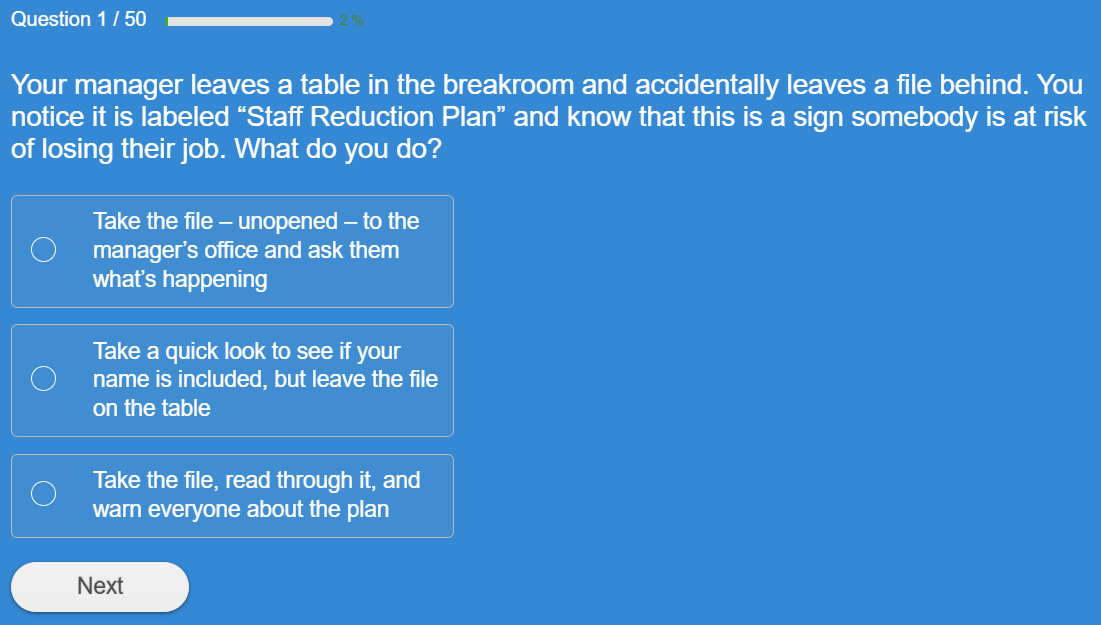
If needed, use secure browsers or proctoring tools—but always pair them with transparent communication about privacy.
3. Technical Glitches
A great test loses credibility if learners can’t complete it due to login issues or poor connectivity.
How to Fix: Always run a short practice quiz before high-stakes assessments to test devices and connections. Prepare a backup plan—such as an offline version or resubmission window—so one technical failure doesn’t derail progress.
4. Ambiguous or Repetitive Questions
Vague, unclear, or redundant questions frustrate learners and make grading inconsistent.
How to Fix: Review each question for clarity and alignment with learning goals. A simple peer or AI-assisted review before launch can catch inconsistencies you might miss under time pressure.
5. Feedback Gaps
Either too much feedback (which overwhelms learners) or too little (which leaves them guessing) can hurt engagement.
How to Fix: Provide quiz feedback immediately, but keep it brief—one line of explanation is often enough. For tests, offer a summary highlighting what went well and what needs focus.

Build Smarter Assessments That Drive Real Learning
Assessments aren’t just checkpoints. They’re opportunities to shape how people think, apply, and grow. When you design them intentionally, quizzes and tests stop being separate tools and start working as a single system that reinforces progress.
Use quizzes to strengthen recall and engagement. Use tests to measure and validate mastery. Then, you can also combine the two for better results: let quiz insights refine your tests, and let test results guide your next quiz cycle.
If you’re rethinking how to approach assessments, start with simplicity. Experiment with one tool, one quiz, one small improvement.
Platforms like ProProfs Quiz Maker make it easy to build interactive, secure, and data-driven assessments that help learners stay engaged while giving you insights you can act on. Because smarter assessments don’t just measure learning — they help create it.
Frequently Asked Questions
What is the difference between a quiz and an assessment?
A quiz is a quick evaluation of a specific topic, while an assessment is a broader process that measures performance, understanding, and growth. In the formative vs summative assessment model, quizzes fall under formative assessments, helping learners improve before they face a graded or high-stakes test.
What is the difference between a quiz and a summative test?
A quiz supports learning during the process — it’s formative and used for feedback. A summative test comes at the end of a learning cycle to evaluate final achievement. Quizzes guide improvement and retention, while summative tests validate that the learning objectives have been met.
What is considered a quiz?
A quiz is a short, focused check of understanding. It often includes multiple-choice or short-answer questions and gives instant feedback. The key benefit of quizzes is that they encourage active recall, making learning more interactive, memorable, and less stressful for participants.
How do quizzes, tests, and assessments work together?
Quizzes build knowledge through repetition and feedback. Tests measure understanding at key milestones. Broader assessments track growth and performance over time. Together, they create a balanced learning cycle that strengthens retention, boosts confidence, and ensures true comprehension — not just memorization.

 We'd love your feedback!
We'd love your feedback! Thanks for your feedback!
Thanks for your feedback!



